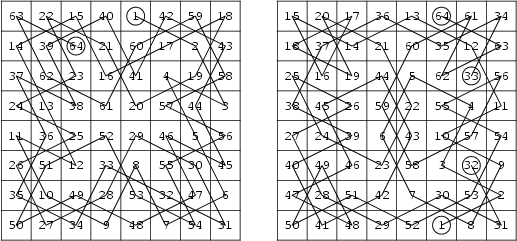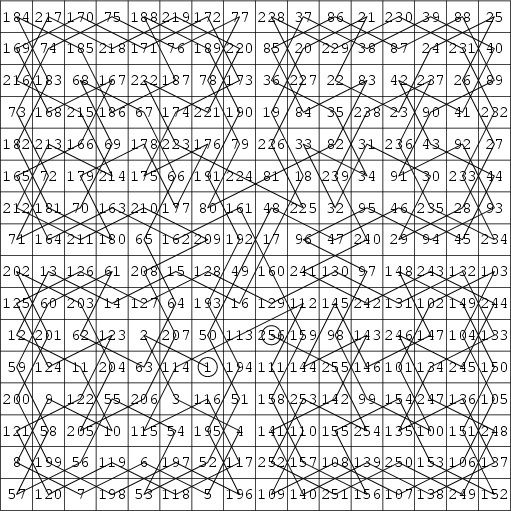|
|
|
Let a chess piece make a Tour on an ![]() Chessboard whose squares are numbered from 1 to
Chessboard whose squares are numbered from 1 to ![]() along the
path of the chess piece. Then the Tour is called a magic tour if the resulting arrangement of numbers is a Magic
Square. If the first and last squares traversed are connected by a move, the tour is said to be closed (or ``re-entrant'');
otherwise it is open. The Magic Constant for the
along the
path of the chess piece. Then the Tour is called a magic tour if the resulting arrangement of numbers is a Magic
Square. If the first and last squares traversed are connected by a move, the tour is said to be closed (or ``re-entrant'');
otherwise it is open. The Magic Constant for the ![]() Chessboard is 260.
Chessboard is 260.

Magic Knight's Tours are not possible on ![]() boards for
boards for ![]() Odd, and are believed to be
impossible for
Odd, and are believed to be
impossible for ![]() . The ``most magic'' knight tour known on the
. The ``most magic'' knight tour known on the ![]() board is the Semimagic Square illustrated
in the above left figure (Ball and Coxeter 1987, p. 185) having main diagonal sums of 348 and 168. Combining two half-knights'
tours one above the other as in the above right figure does, however, give a Magic Square (Ball and Coxeter 1987,
p. 185).
board is the Semimagic Square illustrated
in the above left figure (Ball and Coxeter 1987, p. 185) having main diagonal sums of 348 and 168. Combining two half-knights'
tours one above the other as in the above right figure does, however, give a Magic Square (Ball and Coxeter 1987,
p. 185).

The above illustration shows a ![]() closed magic Knight's Tour (Madachy 1979).
closed magic Knight's Tour (Madachy 1979).

A magic tour for king moves is illustrated above (Coxeter 1987, p. 186).
See also Chessboard, Knight's Tour, Magic Square, Semimagic Square, Tour
References
Ball, W. W. R. and Coxeter, H. S. M. Mathematical Recreations and Essays, 13th ed. New York: Dover, pp. 185-187, 1987.
Madachy, J. S. Madachy's Mathematical Recreations. New York: Dover, pp. 87-89, 1979.